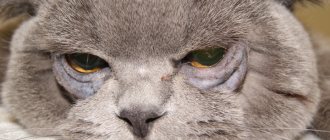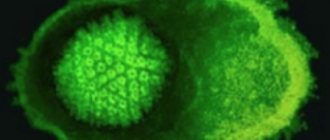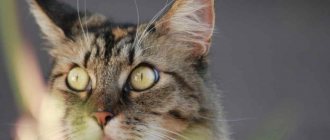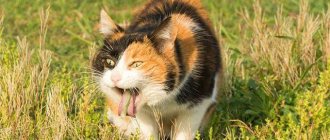Panleukopenia in cats is a fairly common disease. This disease is widely known as distemper. Young animals under the age of 1 year are especially susceptible to it.
Panleukopenia is considered a highly contagious disease. It mainly affects the digestive system, but can also cause complications in other organs.
Etiology of feline panleukopenia
- The causative agent of panleukopenia in cats - DNA - containing a virus of the Parvoviridae family
- Representatives of the feline, raccoon, civet, (mustelidae?) families are susceptible to panleukopenia.
- Virus tropism for actively dividing cells
- The virus can replicate in the thymus and lymphoid tissue of dogs
- Mutation of FPV to CPV, ability to infect cats is lost
- CPV-2 was isolated from leopards (an offshoot mutation)
- Confusion with nomenclature
- Representative of the Viverridae family - spotted lingsang
Panleukopetia - what is it?
According to experts, this disease is caused by a virus that affects the gastrointestinal tract of the animal. After this, you can observe a decrease or complete disappearance of white blood cells. Most often, kittens and unvaccinated adult cats suffer from panleukopenia. The respiratory tract and heart muscle are also affected. The result of the disease is often severe dehydration of the body, which can lead to the death of the animal. Only timely vaccination can reduce the increase in the incidence of this disease. As well as timely diagnosis and correctly selected treatment.
© shutterstock
Pathogenesis
Because immune cells in the blood are attacked by various pathogens, this virus can lead to an anemic state and can open the body to infections from other diseases - viral or bacterial.
In the unvaccinated cat population, panleukopenia is one of the most fatal diseases. The causative virus is very stable and can survive for years in a contaminated environment, so the best preventive goal is to vaccinate the entire cat population.
Kittens between two and six months of age are at greatest risk of developing severe symptoms, as are pregnant and immunocompromised cats. In adult cats, panleukopenia is often milder and may even go unnoticed. Fortunately, cats that survive this infection are immune to any further infection by this virus. On the other hand, there are strains of the panleukopenia virus that provide almost 100% mortality.
Varieties of forms of feline distemper
In general, panleukopenia has several forms. Veterinarians know that distemper can be:
- Super acute.
- Spicy.
- Sub-acute.
In kittens or young pets under the age of 2 years, it is the fulminant form of the disease that most often occurs. The first signs of weakness do not cause any suspicion among the owners, so treatment at this stage is usually not carried out. Further, with every minute the symptoms become more noticeable. Trembling appears, the animal does not want to eat or drink anything. His fur becomes matted and dirty.
Within one day, incredible changes occur in your pet. Damages to the brain and central nervous system become noticeable when the cat throws from side to side. She seems to be thrown from corner to corner, hiding from the light. The first thing that often comes to mind for owners is that their beloved cat has been infected with the rabies virus.
If such signs occur, treatment should be started immediately. It is important to see a doctor as soon as possible. The life of a furry pet counts in minutes. If distemper in cats is not treated and no action is taken, the animal will die within 1-2 days. Other forms of the disease are not so severe, although the risk of death remains quite high.
Symptoms and signs of panleukopenia in cats
The gate of infection is the respiratory tract, gastrointestinal tract.
- Affects rapidly dividing cells: lymphoid tissue (bone marrow, thymus) – leukopenia; enterocytes – destruction of enterocytes – disturbance of maldigestion and malabsorption – diarrhea – dehydration, hypoalbuminemia, hypokalemia, hypoglycemia
- Factors complicating the course of panleukopenia: The presence of other gastrointestinal diseases: cystoisosporosis, helminthiasis, giardiasis, cryptosporidiosis, toxoplasmosis, clostridiosis, salmonellosis, eosinophilic, lymphocytic-plasmacytic infiltration of the mucous membrane, etc.; Poor feeding; Chronic viral infections.
- The incubation period for panleukopenia is 2-10 days
- Clinical signs of panleukopenia: at the beginning apathy, hyperthermia, anorexia, pain in the abdominal wall, prolapse of the third eyelid, then (2-5 days) hypothermia, vomiting, diarrhea, stupor, coma, death
Ataxia in kittens with panleukopenia
- Cause: infection of the placenta with a virus, transplacental infection of kittens, cerebellar hypoplasia, keratitis, hydrocephalus, hydroanencephaly, fetal death
Symptoms
From the moment the infection enters the body until external manifestations, an incubation period of one week passes. The disease has a different course:
- lightning fast;
- spicy;
- subacute;
- chronic (occurs very rarely in adults with a good immune system).
Let's look at the main signs of panleukopenia in kittens:
- Frequent diarrhea and nausea. There may be mucus, blood, and pieces of undigested food in the stool.
- Abdominal pain. The pet does not allow his belly to be touched and gets nervous when pressed.
- Bad breath.
- Colic. The cat often changes position, that is, rolls from side to side
- Slightly elevated temperature.
- Loud rumbling from the stomach.
- Poor appetite.
- Plaque on the tongue.
- Dull eyes and fur.
Main signs and symptoms of feline panleukopenia
- Vomit
- Diarrhea/bloody diarrhea
- Dehydration
- Weight loss
- Heat
- Anemia (due to low red blood cells)
- Rough and disheveled fur
- Depression
- Complete loss of interest in food
- The cat is hiding
- Neurological symptoms (eg, lack of motor coordination)
- Causes of the disease (Etiology of panleukopenia in cats)
Feline parvovirus (FPV, causative agent of panleukopenia)
is the root cause of panleukopenia in cats. Cats acquire this infection when they come into contact with contaminated saliva, blood, feces, urine or other body fluids. The virus can also be transmitted by people who do not wash their hands properly or change clothes between contacts with cats or by materials such as bedding, food utensils or equipment that have been used on other cats.
Washing your hands with soap and water after handling any animal will minimize the chance of transmitting infection to healthy animals.
This virus can remain on many surfaces, so it is important to use safe and effective methods to prevent transmission of this disease. However, even in the cleanest conditions, small amounts of the virus may remain in the environment in which the infected cat was exposed. Feline parvovirus is resistant to disinfectants and can remain in the environment for up to a year, waiting to cause infection.
Kittens can contract the disease in the womb or through breast milk if the pregnant or nursing mother is exposed. As a rule, an unfavorable prognosis does not apply to those kittens that were exposed to this virus in the womb. They receive immunity for some time after birth (colostral immunity lasts about 14 days after stopping breastfeeding). Such kittens can also be exhibited in nurseries, pet stores, shelters and boarding schools.
Is the disease dangerous for humans and other animals?
Feline distemper is absolutely safe for humans, so a cat can be safely treated without fear of becoming infected. However, the virus is dangerous for other animals. Therefore, in addition to vaccination, it is necessary to disinfect the premises and observe quarantine.
As a disinfectant, you can use regular chlorine bleach in an aqueous solution (ratio 1:32).
In addition, to get rid of the virus, you will have to part with all the things of the sick animal: bedding, toys, drinking and eating utensils, litter trays - and replace them with new ones.
A cat that has recovered from panleukopenia will become immune to the disease, but other pets can still become infected, since it is impossible to get rid of the virus 100%. Therefore, a new pet cannot be acquired earlier than a year later; it must be vaccinated in advance or make sure that it has immunity.
Diagnostics
Establishing diagnosis
- Comprehensively: life history data (contact with other cats, place of purchase, visit to a veterinary clinic, hospital treatment), vaccine history (colostral immunity, vaccination window), clinical signs, laboratory tests (general blood count, examination of feces or direct washings). intestines, nasopharyngeal swabs, blood for detection of the virus by PCR - may be false negative), ultrasound
- Blood tests
- White blood cell count less than 5,000
- Lymphopenia
- Thrombocytopenia
- Increased AST, ALT, bilirubin
- Azotemia (usually prerenal causes)
- Hypokalemia
- Hypoalbuminemia
- Hypoglycemia
- Laboratory error - both false negative and false positive information are possible
You will need to provide details about your cat's health and recent actions to your veterinarian. If your cat has recently come into contact with other cats or is going outside at all, it may be important to refer your veterinarian for a proper diagnosis.
Panleukopenia can mimic many other types of diseases
, including poisoning, feline leukemia (FeLV), feline immunodeficiency virus (FIV) and pancreatitis, intestinal and gastric foreign bodies, bacterial infections and helminthic infestations, among others, so it is important to give your veterinarian as much detail as possible so they can prescribe appropriate treatment .
Differential diagnoses for panleukopenia
- Leukemia
- Lymphoma
- Acute poisoning
- Foreign body of the gastrointestinal tract
- Sepsis
Your doctor will then perform a physical examination with routine laboratory tests, including a complete blood count, serum chemistry profile, and urinalysis. Laboratory test results are usually nonspecific, but a significant loss of white blood cells (leukocytopenia) will indicate panleukopenia to your veterinarian.
Feline parvovirus attacks and kills cells that divide rapidly, such as those produced in the bone marrow and intestines, so blood tests usually show a decrease in the number of white cells (leukocytes) and red blood cells.
Tests and diagnostic methods: how pathology is detected
If cases of panleukopenia are frequent in a particular area, an experienced veterinarian will make a diagnosis “by eye” without any problems. But this does not negate the need to conduct a comprehensive examination of a sick cat.
The clinic immediately does a general blood test: in most cases this is quite sufficient. Hematocrit with panleukopenia is impaired in the direction of a sharp decrease in the number of leukocytes. There are especially few neutrophils, and an increased ESR is often observed. If the level of leukocytes in the blood is less than 2-109, then the prognosis, unfortunately, is unfavorable. But still, a final diagnosis cannot be made without specialized tests:
- The most accurate PCR reaction is (but the technique is not cheap).
- Most often, ELISA is performed. In this case, they look for specific antibodies in the blood.
Note that in some regions, ELISA can show almost 100% positive results, and therefore you do not need to completely trust this analysis. In recent years, a situation has become very common when the blood of completely healthy cats contains antibodies to the causative agent of panleukopenia.
Treatment of cats with panleukopenia
Sick cats require immediate treatment and often hospitalization. The first main goal of treatment is to restore body fluid levels and electrolyte balance. Specific treatment will depend on the severity of your cat's illness, but it will likely involve hospitalization for several days in an isolation facility to prevent it from spreading to other animals. Since in cats with panleukopenia the immune system practically does not work, sepsis occurs. Therefore, veterinarians prescribe broad-spectrum antibiotics for panleukopenia, usually intravenously.
What is the treatment strategy for panleukopenia in cats?
- Infusion therapy, electrolyte balance monitoring
- Broad-spectrum antibiotics (cefazolin, amoxicillin)
- Parenteral nutrition
- Beta-leukine, roncoleukin, interferon (virbagen), interferon inducers (cycloferon)
- Blood transfusion of a cat that has been vaccinated or has recovered from panleukopenia
- Antiemetics (thiethylperazine, metoclopramide), antispasmodics, thiamine and other B vitamins (prevention of thiamine deficiency)
- Oral bismuth preparations
- Anticholinergic drugs are contraindicated (platifillin) lead to dynamic intestinal obstruction
- Heparin for suspected disseminated intravascular coagulation
- Complications: DIC syndrome with endotoxemia; Ataxia, fetal myocarditis
- Immunity is strong
- Virus shedding after illness can last up to six months
Good supportive care can mean the difference between life and death. Once your cat returns home from the hospital, you will need to isolate her from other cats until all symptoms have resolved and your veterinarian gives the OK. This may take up to 6 weeks.
This infection has a particularly depressing effect on the physical and mental health of the cat. Your cat will need affection and comfort during the recovery period. It goes without saying that you will need to maintain strict hygiene, and given that this infection can remain on surfaces, be especially clean and careful after handling a sick cat so that you do not inadvertently spread the virus to other cats.
If your cat is treated quickly and effectively, he can make a full recovery. It may take several weeks for your cat to fully recover. Unfortunately, the mortality rate from panleukopenia reaches 90%.
Caring for a cat when sick
Proper care of a sick animal promotes a speedy recovery:
- The cat must be surrounded with love and care.
- The pet should be placed in a warm, dry, dark, but regularly ventilated place.
- Every 2 days it is recommended to disinfect your pet’s sleeping place.
- Do not force feed or water your pet. This will only worsen the course of the disease.
- It is better to give your cat only warm boiled water to drink.
- All animal feces must be removed immediately and the tray treated with disinfectants.
- The pet's eyes, nose and face should be regularly cleaned of accumulated dirt.
- The premises need to be regularly wet cleaned.
- It is strictly forbidden to let your pet go outside.
- It is important to stick to your treatment plan. You cannot use folk remedies and alcohol without permission.
- In the first days after starting treatment, it is recommended to feed your pet dairy products and meat broths. Then introduce carefully chopped boiled beef and deboned sea fish into the diet. A similar diet should be followed for 3-4 weeks. If the animal eats ready-made food, during the treatment period it is necessary to switch it to special food for cats with digestive problems.
Prevention and control measures for feline panleukopenia
Follow your veterinarian's instructions regarding drug administration, household disinfection, and the need for quarantine. If you have other cats, you will need to monitor them closely for signs of illness. Consult your veterinarian about the possibility of vaccinating other cats at home.
Anything your cat touches should be deeply cleaned and disinfected. Anything that can be washed and dried in a washing machine should be washed, and anything that can be washed in a dishwasher should be washed in a washing machine. This includes bedding, toys, dishes and trays, and a trash can.
Again, keep in mind that even then, you may not be able to remove all traces of the virus. Although your cat will not be susceptible to re-infection after recovery, other visiting cats may still be infected by contaminants that were left behind. You can also infect your friends' cats if you visit them.
Vaccination of cats is the most important means of preventing panleukopenia.
Before you bring a new kitten into your home, find out if it has been vaccinated. Fortunately, the vaccine is so effective that just one dose prevents most cases of panleukopenia virus infections. Be alert for any signs of illness, especially in young kittens, and ask your veterinarian to examine your pet as soon as possible if you notice anything of concern.
Risk factors for the disease
There are several factors that increase the risk of contracting panleukopenia:
- Age up to one year and over 6 years. Most often, newborns, slightly older and elderly individuals get sick. This is due to the fact that the animal’s immunity at a young age is not yet fully formed, and at an older age, on the contrary, it is already weakened.
- Warm season. Outbreaks of the disease occur in spring and summer.
- Living in a house with 2 or more cats. If there are several cats in the house, the risk of contracting panleukopenia increases. It is quite difficult to isolate a sick cat in an apartment from other pets. And even after recovery, the animal remains infectious for 1–2 months.
- High contagiousness (infectiousness) of the disease. Parvovirus is very viable. That is why you need to be very careful when visiting various exhibitions, competitions, veterinary clinics, pet hotels and other places where animals gather with your cat.
- Unscrupulous breeders. They take the kittens away from their mother too early, so the babies do not have time to gain immunity from her milk. In addition, such breeders do not give any vaccinations to their pets for sale. Purchasing a cat from an unverified person is a huge risk.
Good to know
- Trichopolum instructions for veterinary medicine
- Instructions for the use of the antibiotic Baytril in animals
- Instructions for use of metronide
- Instructions for ceftriaxone preparations for animals
- Use of Metrogyl in veterinary medicine
- Instructions for doxycycline in animals
- Metronidazole (Metronidazole) for animals (instructions for use in veterinary medicine, doses, indications and contraindications)
- Atovaquone (ATOVAQUONE)
- Azithromycin, instructions for animal therapy
How to prevent your kitten from getting sick.
Most owners, suspecting something wrong, act on the principle: “Now I’ll give the cat a miracle pill and it will recover.” They treat the animal like themselves - with folk remedies. What is happening at this moment? The owner is wasting precious time, which could be spent on diagnostics and making a diagnosis. In addition, these remedies are useless because they are a preventive measure. To kill the virus, use only the right medications prescribed by a doctor.
Many people like to prescribe medications themselves. They do the same as with themselves. They go to the pharmacy and buy something. An animal is different from a person; it cannot say what and how it hurts. They have their own medications for treatment. The owners are not specialists and can only harm, but not cure. Throwing water at an animal is also dangerous. If a cat doesn’t want to drink, it means the body requires it.
Medicines purchased independently from a pharmacy can provoke poisoning and it will be more difficult for the doctor to make a diagnosis. Additional stress on the cat's body can cause rapid death. If you decide to take her to a veterinary center, then place a soft bedding in the carrier, but it would be better not to carry a sick animal, but to call a doctor at home.
Treatment is more effective when taken together. The virus is capable of mutation, making the selection of therapy even more difficult. For each individual case, appropriate drugs are selected. It all depends on the condition of the animal, the degree of infection, etc. The prescribed medications support the cat’s exhausted body and slow down the reproduction of viruses.
Treatment is prescribed strictly individually. The owner must follow all doctor's recommendations. It is necessary to look after and properly care for the animal and monitor its well-being. If deterioration occurs, you should immediately call the veterinarian to your home again, as additional therapy may be required.
The second sign is the appearance of vomiting
Eruption of gastric contents is the second clear sign of panleukopenia. The period from the moment the pathogen enters a susceptible organism until the first signs appear ranges from 3 days to 2 weeks. As a rule, the symptoms of feline distemper develop quickly, the cat immediately loses its appetite and vomits. Nausea and subsequent eruption of gastric contents indicate the process of intoxication and inflammation in the body.
Vomit may be foamy and greenish-yellow in color. With serious changes, there may be streaks of blood in the vomit. Attacks of nausea and vomiting are very frequent - up to several times in 1 hour. The animal, depressed against this background, tries to retire to a secluded place. The danger of vomiting during panleukopenia is the development of dehydration.
How can a cat become infected with distemper?
There are several ways a cat can become infected with the distemper virus. In each of them, the source is the biological secretions of an already sick animal or a carrier of infection.
Infection method
Detailed description
Direct contact
A pet can “catch” the disease by directly touching objects that the sick animal has come into contact with. The virus can enter the house and on the owner’s belongings.
Oral route
Distemper infection will also occur if you eat food or drink that contains the infection.
Through the air
If a healthy cat is in the same room as an infected one, then panleukopenia cannot be avoided.
Through bites
Blood-sucking insects are capable of transmitting the feline distemper virus.
In utero
The feline distemper virus is able to cross the placental barrier. In most cases, fetuses die before birth. If the kittens succeed in being born, then in the near future (no more than two days) they still die.
Many owners are interested in whether a cat can get distemper from a dog? No, he can not. The viruses that cause plague in these animals are completely different.
Prevention of plague
Don’t forget about vaccination, and the risk of getting distemper will be minimized
The most effective preventative measure for feline distemper is vaccination. Since there are currently enough vaccines, the doctor chooses at his own discretion. The following drugs are popular: Nobivak, Multifel, Feleniffa.
Kittens are first vaccinated at 1.5-2 months, and after 3-4 weeks they are revaccinated. Subsequently, the vaccine is administered once a year.
You can prevent a deadly disease by not letting newborn kittens go outside, preventing your pets from escaping and interacting with unfamiliar family members. In addition, it is necessary to monitor the immune system of your mustachioed friend, providing the cat with adequate nutrition and vitamins.
Treatment of cats
How and with what to cure plague? The success of treating the disease depends on three factors: the timeliness of the start of therapeutic measures, the intensity of treatment and the use of an integrated approach.
First of all, you need to provide comfortable living conditions for the animal. A sick cat should be isolated in a heated room, away from bright sunlight and protected from drafts. The room temperature should be maintained between 20°C and 24°C. You cannot allow a situation in which the cat can leave the house.
Traditional recipes for treating distemper (vodka with eggs) can only lead to the premature death of your pet!
Diet at home. After the initial symptoms appear, you need to limit the sick pet’s diet to a minimum. The cat should have constant access to warm boiled water, to which it is allowed to add infusions and decoctions of plants known for their anti-inflammatory and expectorant effects. You can drink a drink with added vitamin C (ascorbic acid). To supplement your pet's diet with some calories, you can prepare an unsaturated broth based on beef, chicken or fish for your cat. You should not force your pet to quench its thirst.
After the third day of therapy, the cat can be offered a certain amount of liquid porridge made from rice or oatmeal, which was prepared in water or liquid meat broth. If the first small portion is well absorbed and does not lead to vomiting or diarrhea, it is recommended to increase the frequency of meals and portion size. For one hundred milliliters of porridge, you can add a teaspoon of minced protein. Every other day, you can introduce a raw or boiled egg into your diet. After a week of treatment, in the absence of alarming symptoms, the sick pet can be returned to its normal diet.
The pet owner should remember the healing effects of enemas on the inflamed intestines in order to free the body from toxic contents. A weak solution of baking soda (0.1% sodium bicarbonate solution) is injected into the cat's rectum, after which the procedure can be repeated using medicinal infusions of chamomile, oak bark or St. John's wort. The temperature of the solution should be in the range of 20°C - 30°C to cause vasoconstriction and contraction of the intestinal muscles. An enema with a cleansing effect should contain a volume of healing liquid in the range from 20 to 200 milliliters. A veterinarian will help you determine the volume depending on the weight of your pet. The next stage of treatment is enemas with nutrient broth, which are given 3-4 times during the day. When cooking beef or chicken broth, after the first boil, all liquid should be drained, add water and wait for the second boil. The pet owner should continue to give nutritious enemas until the alarming symptoms disappear and the cat’s appetite is restored.
Additional therapeutic measures include the use of a variety of immunoglobulins to maintain the natural immunity of cats. Among such drugs, Vitafen serum with a wide spectrum of action, used against chlamydia, rhinotrachseitis, and calicivirus in cats, occupies an important place.
Immunoglobulin with a specific action against panleukopenia in cats is also used. Modern treatment methods involve the use of a variety of immune system stimulants (thymolin, alversan, apistimulin and others).
Complex therapy includes a technique to combat minor bacterial microflora. At this stage of therapeutic measures, different types of antibiotics, sulfonamide drugs and nitrofurans are used. Sulfonamides (sulgin, biseptol, septrim, phthalazole, sulfadimethoxine and others) are dosed in three doses per day. In case of gastric intoxication, antibiotics should be administered by subcutaneous or intramuscular injection. Antibiotics of the penicillin group: ampicillin have the least toxic effect. ampiox, oxacillin, as well as cephalosporins: claforan, cefamezin, lagocef. The course of treatment ranges from five days to a week.
The use of streptomycin, chloramphenicol, tetracycline, and quinolones is not recommended. These products are contraindicated for cats and are highly likely to cause allergies. The use of nitrofurans is recommended for the most part for the manufacture of products used to disinfect the mucous membrane of the eyes, urinary tract, rectum, nose and mouth. Before using immunoglobulins, antibiotics and sulfonamides, antihistamines (diphenhydramine, pipolfen, suprastin) should be administered.
To relieve muscle spasms or avoid vomiting in cats, the doctor must administer a solution of no-spa (2%) in a dosage of 1 milliliter. In the absence of no-shpa, you can use cerucal or papaverine. To support the animal's body, multivitamins, microelements, vitamins B and C are administered. To maintain cardiac activity, camphor, caffeine, and cordiamine are prescribed. For severe symptoms of dehydration, glucose (5%), Ringer's solutions and similar substances (dosage from ten to one hundred milliliters) are injected into the withers or intravenously two to six times daily. When prescribing medications, it should be taken into account that the simultaneous administration of a large amount of drugs can harm the furry patient. Therefore, taking into account the compatibility of the drugs, droppers with a general rehydration solution for intravenous use should be prescribed.
Excessive use of antimicrobial treatment can lead to inhibition of beneficial microflora of the stomach and intestines. Taking into account this factor, a sick animal should be prescribed drugs to maintain an optimal balance of microflora (Linex, Hilak) and enzymes for the normal functioning of the stomach (Pancreatin, Festal). These substances should be taken with meals. In critical situations, blood transfusion is recommended.
Prescriptions for a kitten aged two to three months include injections of glucose (5% - 1 ml), vitamins B6 (0.1 ml) and B12 (0.1 ml), riboxin (0.2 ml), vitamin C ( 0.2 ml), cocarboxylase (quarter ampoule), Ringer-Locke solution (8 ml). Of the antibiotics, you can give a solution of cefotaxime (dissolve 1 g in 5 ml of Ringer-Locke, injections of 0.4 ml 2 times a day with an insulin syringe, course - week - ten days).










